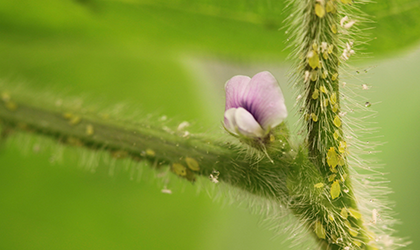

Written collaboratively by Adam Varenhorst, Patrick Wagner, Amanda Bachmann, Cole Dierks, Brady Hauswedell, and Philip Rozeboom.
Pyrethroid Resistant Soybean Aphids
For the last two years, we have been hearing of pyrethroid resistant soybean aphids in our neighboring states of Minnesota and more recently Iowa. These pyrethroid resistant soybean aphid populations were initially detected due to field wide failures of foliar applied pyrethroid insecticides. Although the soybean aphid undergoes a complex lifecycle which may have reduced the initially observed resistant populations in Minnesota, additional reports have been occurring. In 2016, pyrethroid resistant soybean aphids were observed in Northwest Iowa.
South Dakota Populations
It is not too much of a surprise that during 2017 we observed populations of the soybean aphid in South Dakota that are resistant to pyrethroid insecticides. So far, our observations have been that the soybean aphid populations are resistant to products containing the active ingredients bifenthrin and lambda-cyhalothrin. So far, we have only observed pyrethroid resistant soybean aphids near Volga, SD. However, we will continue checking populations throughout Eastern South Dakota to determine how widespread these populations are.
With soybean aphids reaching the speed scouting and 250 soybean aphids per plant thresholds in soybean this week it is possible that many more cases of pyrethroid resistant soybean aphids may be observed. If you believe you have a field failure of these products please contact Adam Varenhorst.
Scouting & Management
We would like to collect samples of the soybean aphids for lab testing. With the observation of the pyrethroid resistant soybean aphids in South Dakota, it is going to be very important to consider managing these pests with products other than pyrethroids. For a list of insecticides that are labeled for soybean aphid management please refer to the most current edition of the South Dakota Pest Management Guide: Soybean.
The majority of soybean that we scouted are somewhere between the R5 and R6 growth stages. If the observed soybean aphid populations within a field have not been rapidly increasing and soybean are at the R6 growth stage we recommend that insecticides are not applied for soybean aphid management. In addition, be aware of the restricted harvest interval on insecticides, which may result in delayed harvest depending on when the application is made.






Post a comment
Report Abusive Comment